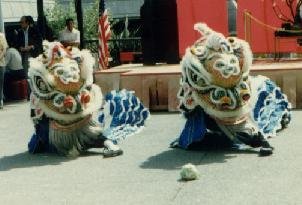When people think of lion dancing, the last thing that comes to mind would probably be the music behind the lion’s movements. In fact, during performances, the audience rarely concentrates on the musical instruments – the focal point of the lion dance is the lion. Honestly, I think this should be changed. Drumming is an art form in itself. It’s just as hard as learning the lion dance movements. A lot of people who learn drumming after learning the lion movements get discouraged easily because of this difficulty. Not only do drummers have to continuously play the beats, they have to look after the lion and adjust the music according to the situation. Basically, the music is what keeps the dance alive – it is the lion’s heartbeat.
When I first started lion dancing, I didn’t get to go under the lion head. Before I was able to learn the lion’s movements, I needed to be able to play the cymbals first. Playing the cymbals is a lot easier than playing the drum for most people. I was able to learn the cymbal beats pretty quickly, so my Sifu decided to teach me drumming too. The first thing I learned was the “proper†way to hold the drum sticks. I was taught to hold it gently with my thumb and index finger, like this:

Picture taken from http://www.guardian.co.uk/lifeandstyle/2011/jun/19/food-guilty-pleasures-jay-rayner


